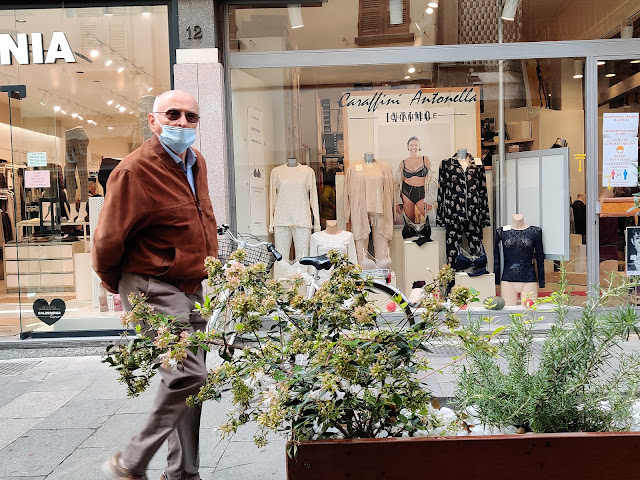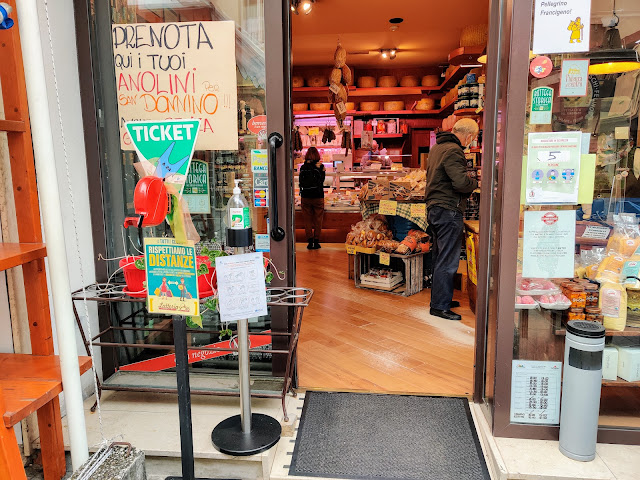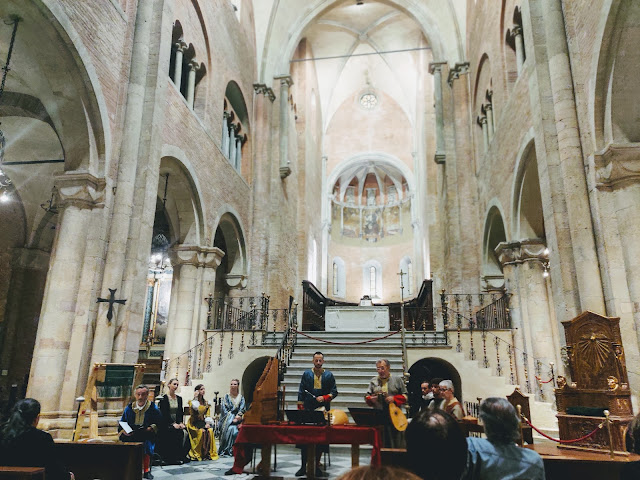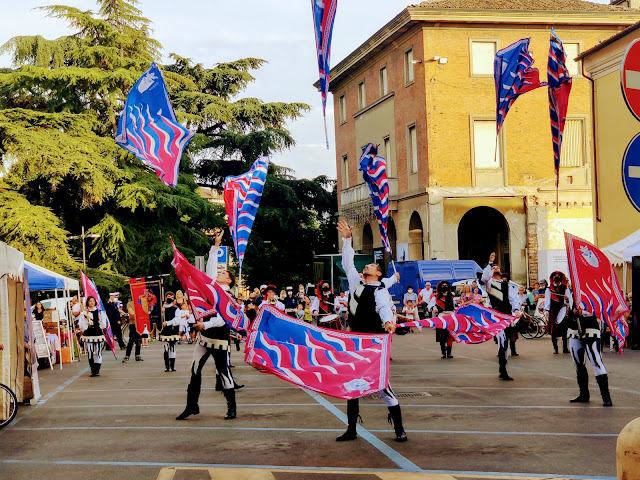 |
| The San Giorgio menu--it's different every day. |
 |
| Colazione di campioni. |
 |
| Pasta at San Giorgio. |
 |
| Two kids high on life and protein. |
 |
| The San Giorgio menu--it's different every day. |
 |
| Colazione di campioni. |
 |
| Pasta at San Giorgio. |
 |
| Two kids high on life and protein. |
On Sunday, after Pam and I had finished playing some violin-viola duets and she headed home, I stepped onto our balcony. In the street below I was surprised to see dozens of people, maybe as many as 150, standing around, all masked, all clearly waiting for something, but I couldn't imagine what.
The next afternoon there weren't as many people waiting around, but it was more obvious what they were doing: forming a long line to get into the pharmacy across the street.
Then I remembered that the preceding Friday, Oct. 15, Italy had announced an expansive new vaccine mandate. By law, no one can enter their workplace without a Green Pass showing they have been vaccinated or have had a recent negative COVID test. Those without a pass must stay away, and won't be paid. If they show up anyway they face stiff fines.
So evidently the folks in line for the pharmacy were there either to get tested or to update their Green Passes, both services that most pharmacies here provide. Without the pass, they couldn't go to work.
That same day the town hospital was helping out by offering vaccinations to all comers. The mayor reported that more than 900 people got jabs that day. "Meglio tardi che mai," he said. ("Better late than never.") That's a significant number of vaccinations in a town of 27,000. According to the mayor's very active Instagram account, 84.3 percent of the town's residents are now vaccinated, including more than 81 percent of teens between 16 and 19. Italy overall is about 80 percent vaccinated.
The horrifying death toll of the pandemic's first wave in Northern Italy probably encouraged people to take COVID seriously and protect themselves. Aside from one ultra-right-wing riot in Rome, protests against the new mandate have been small.
Meanwhile, we are now two weeks out from the San Donnino festa and its happy, often maskless crowds, and there doesn't seem to have been an uptick in COVID infections here, at least not that anyone's reporting. Maybe it's because so many are vaccinated. Or maybe being out of doors makes the virus less effective. Or maybe San Donnino was watching over the celebrants and adding COVID prevention to his roster of miracles.
It seems like a good omen that when I looked out this afternoon, what people were lining up for was gelato.
Over the San Donnino festa weekend we did our own bit to honor the saint by having several bowls of anolini in brodo. One batch we purchased at the Antica Trattoria del Duomo, the best restaurant in town. Later we got another helping from the Latteria delicatessen downstairs.
Compared to the other pasta specialties of this area--tender square tortelli filled with cheese and herbs or pumpkin, served with melted butter--anolini are a rougher dish. The pasta is a bit thicker, and inside is a mix of little more than breadcrumbs and Parmesan. The anolini are served in a simple, not very rich broth. This is something you can imagine poor peasants dining on when there was not much else to eat.
The last time I had anolini in brodo was during the festa back in 2018, when I bought some from a busy stand just outside our front door. I hadn't liked them much; the broth was over-salted and watery and the filling was harsh, the bite of the cheese untempered. Not surprisingly, the anolini we got from our two upscale local sources were vastly better, although each had its own character. The Antica Trattoria broth was light but flavorful, and the filling of the anolini had just the right balance of starch to cheese, so that they tasted almost creamy. I gobbled them down before I realized I should have taken a photo.
We had enough broth left over to use with the Latteria's anolini, which had a bit more bite and an interesting, slightly funky overtone. I'm not sure if the Latteria puts a bit of prosciutto into their filling, or the anolini just picked up some of the store's intoxicating smell, but either way they were delicious, too. That's them in the photo above.
On Saturday, Oct. 9, the saint's actual feast day, the party continued. As afternoon gave way to evening the music swelled outside, and the crowds got bigger and more raucous.
Supposedly everyone in the town's public areas had to have a vaccination green pass, enforced by spot checks. Anyone caught without a pass would face a fine of anywhere from 400 to 1,000 euros (about $450 to $1,150). But we never saw any spot checks going on, and masks weren't worn much, either, especially later in the evening.
 |
| Some were cautious. |
 |
| Many others, not so much. |
Since the annual San Donnino festa is likely to be part of our life, and therefore of this blog, for some time to come, it seems like a good idea to present the details of his story all in one place, instead of continuing to dribble them out a bit at a time, as I've been doing. Here, then, is the man behind the holiday.
San Donnino, a.k.a. St. Domninus, is a distinctly minor figure in Catholic hagiography, pretty much unknown anywhere but Northern Italy. Therefore there's very little solid information about him; this is more legend than history. Domninus was born in Parma sometime in the second half of the third century CE and became a high official in the Roman hierarchy, serving as chamberlain and keeper of the royal crown to Emperor Maximian.
A bas relief on the front of the Fidenza Duomo, below the figure of St. Simon Peter pointing the way to room, shows Domninus placing the crown on Maximian's head, apparently one of his daily duties.
 |
| You can see Domninus crowning Maximian in the lower right. |
Maximian and his co-emperor, Diocletian, were pagan conservatives and in 303 CE they launched a vigorous campaign of persecution against Christians and other religious minorities. Christians were purged from the military, their churches were destroyed, their property was seized, and those who refused to make sacrifice to the Roman gods were sometimes put to death.
This didn't stop Domninus from secretly converting to the Christian faith. But in the year 304 Maximian discovered his chamberlain's heresy and ordered his execution. Domninus fled but Maximian's troops caught up with him just outside of what was then the Roman town of Fidentia as he was about to cross the river Stirone. They seized him and cut off his head.
But empowered by his Christian faith or some autonomic nervous response, Domninus rose up, picked up his severed head, walked across the Stirone. and lay down on the ground on the other side, cradling his head in his arms--a rather pointless gesture, but clearly miraculous.
Another bas relief on the front of the cathedral shows Maximian wielding a sword on the left, on the right Domninus crossing the river with his head in his arms, and, in the center, the headless martyr being elevated to sainthood by two angels.
 |
| Interesting use of non-chronological storytelling. |
A few decades later the bishop of Parma dreamt that a saint was buried in a spot by the Stirone, next to a brick inscribed, "Here is hidden the body of St. Domninus, martyr for Christ." With the assistance of this rather obvious clue, San Donnino's relics were found. The persecution of Christians having eased under the new emperor, Constantine, a small church was erected in that place to house what was left of the saint, whose name by now had been Italianized to San Donnino.
One day a man came to where San Donnino was buried to pray for help. His horse had been stolen and he wanted it back. Lo, the horse was returned.
Walking while decapitated is certainly impressive, but not particularly endearing, and the miracle of the stolen horse seems to be neither. Nevertheless, San Donnino attracted enough devotees that the church had to be enlarged. over the next century or so. In the process it was noticed that, although the church had been built over the saint's remains, no one had kept track of exactly where they were. But a priest, inspired by divine intuition, discovered the saint's relics underneath the church in a sarcophagus labeled, "Here lies the body of the most blessed martyr Donnino." Again, this seems more obvious than miraculous, but perhaps you had to be there.
 |
| A more recent portrait of San Donnino inside the cathedral. |
Donnino's posthumous popularity grew and more and more pilgrims began coming to pray in his church. So large were the crowds that one day as a group of pilgrims crossed over the Stirone the wooden bridge collapsed beneath them. "But--a miracle!--thanks to the intercession of San Donnino no one was hurt, including a pregnant woman on whom numerous other people had fallen," reports the Fidenza cathedral's website.
 |
| The pregnant woman and the collapsing bridge, also on the cathedral facade. |
This painting, by Cristoforo Savolini, shows Saints Borromeo and Appolonis (two other C-list saints) flanking Saint Domninus, who wears the outfit of a Roman centurion. I assume the dog is there because of the Fidenza saint's anti-rabies powers, although to me he looks not only non-rabid but like a very good boy.
Poor San Donnino's remains were once again mislaid when some unspecified enemies of Catholicism razed the church in the 600s or so. But in the eighth century Charlemagne was en route to Rome to be crowned Holy Roman Emperor when (the story goes) his horse abruptly stopped at a spot by the Stirone and refused to go any farther. An angel appeared and told the soon-to-be emperor to dig for treasure in this spot. The treasure turned out to be San Donnino's relics.
In a smart piece of medieval marketing, the village (borgo) where all these things occurred renamed itself Borgo San Donnino, and the structure housing the saint's remains became ever grander. In the 1100s construction of the present Duomo began and continued for a century and more. The cathedral became an important stop on the Via Francigena pilgrimage route, and the sculptures decorating the facade include not only images of the saint and his martyrdom but also numerous depictions of pilgrims making their way to Rome and the Holy Land.
Inside the cathedral is San Donnino's sarcophagus, which also features bas reliefs of his martyrdom and his miracles. Below the statue of the headless saint, the panel on the right shows, again, San Donnino crowning the Roman emperor. I'm pretty sure the panel on the left depicts the man praying for the return of his horse.
 |
| You know it's him because his head is on his chest. |
In the 1920s, when Mussolini's regime was seeking to rebrand Italy as Imperial Rome 2.0, the town fathers decided to change its name from Borgo San Donnino to Fidenza, a phonically updated version of the old Roman name.
The saint and his cathedral nevertheless continue to loom large in the city. The Duomo is the city's most distinguished architectural feature, and although it's quite ascetic compared to the gaudy cathedral extravaganzas in many other Italian towns, here in Fidenza it's one of the few things of any interest to tourists. San Donnino's legend is part of the cathedral's appeal, and the town's, if only because it's so old and so odd. And the annual festa in the saint's honor is Fidenza's biggest event of the year and a source of community pride and pleasure.
Whether or not San Donnino really carried his head across the river, whether or not he cured rabies or restored stolen horses to their owners, nowadays he is certainly doing a lot for Fidenza. It's no wonder they love him for it.
Early Saturday morning I came out of our door a little after eight and was astonished to see the street clean and La Strega sedately serving coffee. Fidenza knows how to party and how to clean itself up afterwards.
I was out at this early hour to join Pam and a few other local exercise buffs for a walk along one small part of the Vig Francigena pilgrimage route, an event left over from the Via Francigena Festival a few weeks before. We gathered at the Piazza Grande, had our green passes checked, and took a van out to the little village of Castione Marchesi, about 8 kilometers (5 miles or so) away There we disembarked and headed south to Fidenza on foot.
 |
| I think those are the Appenines in the distance, but don't quote me. |
Almost all of our walk went through the farmland that surrounds Fidenza and other towns in this part of Emilia. We passed fields of alfalfa and cornfields that were being turned for next spring's crop. The crane by this barn is for an irrigation system.
 |
| No one home? |
 |
| A railway station falling into ruins. |
We also saw a couple of hunters and their dogs out in a field, fortunately pointing their guns away from us. Others in our group, who sounded knowledgeable, said they were hunting for pheasants or hares.
Although we were out in the country, we weren't on an unpaved track. The photo below is what a pilgrimage road in the country ought to look like, right? But it was just someone's driveway.
Instead pretty much our whole walk was on paved highways with no sidewalks and altogether very little room on either side. Despite their centuries-old history as routes for pilgrims and other foot travelers, these roads are not pedestrian-friendly.Luckily there was very little traffic. But crossing this narrow-shouldered bridge over the busy autostrada was a little unnerving. Antonio took the lead and waved his neon-yellow vest whenever a car or truck came by to make sure they didn't accidentally mow us down.
Soon we could see the tower of a Fidenza church up ahead--not the Duomo, but St. Michael's at the other end of the oldest part of the city. It's poking up right in the middle of the photo below.
A little while later we came out into the parking lot behind the train station. That's the back of the cemetery on the left. I found this juxtaposition--life and death, the excitement of going places and the tedium of stasis, the exhaustion of travel and the soothing prospect of eternal rest--a fitting finale to our excursion.
Every year Fidenza marks October 9, the feast day of San Donnino, with a multi-day festa. We were last here for this event in 2018, and were amazed at how big a deal it was. The party for the town's patron saint was at least five days long, with additional events days before that, and what seemed like the whole population turned out to eat and drink and cram together to joyfully scream at each other over booming pop music late into the night. Our friends told us that San Donnino is bigger than Liberation Day, bigger than Christmas, the most significant public holiday on the town's busy calendar. And our street in the center of town is also the epicenter of the festivities.
Last year, with fear of COVID keeping everyone cowering behind their own doors, we were stuck in California and in Fidenza the festa was sadly truncated. There were a handful of art exhibits, a couple of outdoor talks and tours, a few food booths in an outdoor space where only a limited number of people--masked, of course--could be at any one time. It was hardly San Donnino at all.
In 2021, despite the threat of COVID still hanging over us all, people--particularly younger people--were ready to let loose again. And although this year's festa was shorter (the meat of it was really only three days long), smaller (with many fewer booths selling food, drink, and tat of various kinds), mostly outdoors, and strictly controlled (at least in theory), the party, while it lasted, was quite the bacchanal.
This year's theme was the environment and climate change, always a major concern of the town's center-left government. To that end, a forest--a temporary and very tidy forest--was summoned into existence in the town's main square. A crew quickly rolled out sod to cover one end of the piazza and unloaded dozens of trees and plants.
 |
| Che bella figura! |
 |
| All eating, all drinking. |
 |
| Our qi-gong classroom, fully disinfected. |
 |
| Taking a breather. |
 |
| Clean hands, clean conscience. |
 |
| They went thataway. |
 |
| Singers were accompanied by a harmonium, a lute, a hurdy-gurdy, and scallop-shell castanets. |
 |
| Town notables were on hand, including an officer of the carabinieri (I think). |
 |
| Like juggling, but with flags. |
 |
| Pausing en route for some music. |
 |
| At the top of the pole. |
Quanto? Tanto! has moved over to Substack, where the nuts and bolts of this sort of operation are more up to date. Please join me over ther...